Abstract
Background: Artificial intelligence (AI) is increasingly integrated into orthodontic workflows, including digital model analysis modules embedded in orthodontic software. While these systems offer efficiency and automation, the accuracy and clinical reliability of AI-generated measurements and diagnostic assessments remain unclear. Therefore, to use AI systems safely and effectively in clinical orthodontics, it is important to check their results by comparing them with those of experienced orthodontists. Methods: Digital models of 48 patients were analyzed by the Orthodontist group and two AI platforms: Titan (full) and SoftSmile (Bolton only). Three orthodontists independently measured all variables using 3Shape OrthoAnalyzer, and group means were used for comparison. A subset of models was reanalyzed after two weeks to assess consistency. Data distribution was evaluated, and appropriate statistical tests were applied. Reliability was assessed using intraclass correlation coefficients (ICC) and Cohen’s kappa. Results: Almost perfect agreement was observed between the orthodontists and Titan AI in molar classification (κ = 0.955 right, κ = 0.900 left; p < 0.001), with perfect agreement reported across all groups—including between the orthodontists themselves—for Angle classification (κ = 1.00). In anterior and overall Bolton analyses, no meaningful agreement was found between the orthodontists and AI platforms. However, in a subset of patients where all three methods identified the tooth size discrepancy in the same arch (either maxilla or mandible), no significant differences were found in anterior (p = 0.226) or overall Bolton values (p = 0.795). Overjet, overbite, and space analysis values showed significant differences between the orthodontist and Titan groups (p < 0.001). ICC analysis indicated good to excellent intra- and inter-rater reliability within the orthodontist group (≥0.77), while both AI systems demonstrated excellent internal consistency, with ICC values exceeding 0.95. Conclusions: AI-based platforms showed high agreement with orthodontists only in Angle classification. While their performance in Bolton analysis was limited, significant differences were observed in other linear measurements, indicating the need for further refinement before clinical use.
1. Introduction
In recent years, advances in digital dentistry have led to the increasing use of intraoral scanners in clinical practice. Compared to conventional impression techniques, these scanners enable faster, more comfortable, and highly accurate data acquisition. They also facilitate orthodontic diagnosis and treatment planning by allowing for the rapid and seamless transfer of digital data, instant access to patient records, and a reduced need for physical storage [1,2].
Alongside these developments, the integration of digital technologies into orthodontics has enabled more sophisticated planning tools. Digital software platforms now allow for the simulation and visualization of treatment outcomes in three dimensions, significantly enhancing the precision of diagnosis and treatment planning [3]. These tools rely heavily on the digital models produced by intraoral scanners, underscoring the critical role of accurate digital impressions in modern orthodontic workflows.
In this context, clear aligner systems have emerged as a popular orthodontic treatment modality that aligns with the capabilities of digital workflows. They not only meet patients’ aesthetic expectations but also offer enhanced comfort, reduced pain compared to fixed appliances, and fewer clinical appointments [4,5]. The effectiveness of these systems depends on precise digital analysis and planning, which are made possible through the combined use of advanced scanning and modeling technologies.
With recent developments in computer technology, artificial intelligence (AI) has increasingly been integrated into the medical field [6,7,8]. In orthodontics, AI has been applied to various tasks, including digital model analysis, malocclusion classification, anatomical landmark identification, prediction of post-treatment facial changes, classification based on clinical photographs, and tooth segmentation [9,10,11,12,13,14,15].
Comprehensive diagnosis and treatment planning are essential for successful orthodontic outcomes. Model analysis plays a central role in this process, incorporating evaluations such as space analysis, Bolton analysis, Angle classification, and overjet and overbite measurements [16].
Space analysis is a fundamental diagnostic parameter in orthodontics, traditionally performed by comparing the total mesiodistal widths of the teeth to the arch length. In digital models, the arch length is often defined as the curved distance measured along a digitally constructed arch form extending from the mesial surface of the right first molar to that of the left first molar [17]. The construction of this curve may be subject to variation due to subjective interpretation. This analysis reveals the relationship between required and available space, helping determine whether the teeth can be properly aligned. It is a fundamental mathematical equation that can directly influence decisions regarding extraction or non-extraction treatments [18].
Bolton analysis evaluates the mesiodistal tooth size ratio between the maxillary and mandibular teeth [19]. Even if ideal occlusion (in terms of cusp fossa relationships, overjet, and overbite) is present, minor spacing or crowding in one arch may indicate a Bolton discrepancy [20]. This analysis helps identify the amount of tooth size excess or deficiency in each arch, guiding the necessary corrections to achieve a Class I molar relationship and ideal occlusion [21].
Overjet is defined as the horizontal distance from the incisal edge of the maxillary central incisor to the labial surface of the mandibular incisor, measured parallel to the occlusal plane. Overbite is the vertical distance between the incisal edges of the upper and lower central incisors [20]. These parameters assess the antero-posterior and vertical relationships in the anterior region and are essential for identifying esthetic and functional problems. They serve as key references for accurate diagnosis and effective treatment planning [22].
Angle classification describes sagittal dental relationships using the maxillary first molar as a reference point. Class I is diagnosed when the mesiobuccal cusp of the maxillary first molar fits into the mesiobuccal groove of the mandibular first molar. A distal relationship of the mandibular first molar indicates Class II, while a mesial relationship indicates Class III [23]. This classification allows accurate evaluation of the anteroposterior dental relationship and plays a central role in diagnosing malocclusion and establishing individualized treatment plans [24].
These diagnostic parameters and analyses play a crucial role in orthodontic diagnosis and treatment planning by enhancing clinical decision-making and treatment efficiency. Traditionally, orthodontic measurements were performed manually on plaster models. However, challenges such as storage requirements, the risk of damage, and potential data loss have led to the widespread adoption of digital models as a preferred alternative [25,26]. Although two dimensional digital images were initially introduced for archiving purposes, the use of three-dimensional digital models capable of supporting comprehensive analyses has largely replaced plaster model assessments in clinical orthodontics alternatives [26].
Quimby et al. [25] reported that digital measurements of mesiodistal widths, arch length and width, overjet, and overbite are comparable in accuracy and repeatability to those obtained from traditional plaster models. Despite these technological advancements, manual measurements on digital models remain time consuming and are subject to variability among clinicians [26,27].
To overcome these limitations, artificial-intelligence-assisted automation has been introduced to reduce clinical workload, minimize diagnostic inconsistencies, and improve the overall quality of care [14,27,28,29,30]. Recent studies have demonstrated that AI-supported systems enhance diagnostic consistency by reducing human error and increasing standardization across clinical assessments [25]. These tools also accelerate data processing, improve decision-making accuracy, and support more efficient treatment planning [27,29].
In light of these developments, artificial intelligence has become increasingly integrated into orthodontic workflows, offering practical solutions that streamline routine processes while supporting better clinical outcomes. Nevertheless, ongoing validation remains essential to ensure the reliability and appropriateness of these systems in everyday practice. The aim of this diagnostic accuracy study was to compare six key components of digital orthodontic model evaluation, namely overjet, overbite, Angle classification, space analysis, anterior Bolton analysis, and overall Bolton analysis, between assessments performed by experienced orthodontists and those generated by AI-based software.
The alternative hypothesis (H1) was that AI-based 3D model analysis tools would show statistically significant differences and variable diagnostic agreement compared to clinician assessments across both numerical and categorical orthodontic parameters.
2. Materials and Method
2.1. Study Design
This retrospective diagnostic accuracy study was conducted in accordance with the STARD 2015 (Standards for Reporting Diagnostic Accuracy Studies) guidelines [31]. An a priori sample size calculation was performed using G*Power 3.1 (Heinrich-Heine-Universität Düsseldorf, Düsseldorf, Germany) to determine the minimum number of participants required to detect a statistically significant difference between artificial-intelligence-assisted and manual measurements. The analysis was based on a two-tailed paired t-test, assuming a medium effect size (Cohen’s dz = 0.45), a significance level (α) of 0.05, and a statistical power (1–β) of 0.85. Based on these parameters, the minimum required sample size was calculated to be 47 patients.
Patient records from the İnönü University Faculty of Dentistry Hospital dated 2017–2022, including male and female individuals aged 13–25 years, were reviewed. An initial pool of 735 dental models meeting the study’s predefined inclusion criteria was identified from the records of 1050 patients. From this pool, 50 patient models were randomly selected using an online random number generator (https://www.calculatorsoup.com, accessed on 8 July 2025). Prior to any analysis, all patient data were anonymized by a resident in the orthodontic department before being uploaded to the respective digital platforms. A total of 50 participants were initially included in the study. However, due to irreparable issues with the intraoral scan mesh files of two patients, the final analysis was conducted using data from 48 patients.
2.2. Inclusion Criteria
- Presence of fully erupted permanent teeth from central incisors to first molars
- High-quality intraoral scans showing properly captured teeth and gingiva
2.3. Exclusion Criteria
- Presence of primary teeth or extensively decayed teeth
- Crowns, bridges, or restorative dental work affecting tooth anatomy
- Models with faulty occlusion or incomplete scans
- Scans containing major defects or large gaps
2.4. Measurements
The selected patient models were uploaded to two web-based platforms: Titan Dental Design (https://titandentaldesign.com/, accessed on 8 July 2025, v1.2.4 a2) and SoftSmile (https://softsmile.com/, accessed on 8 July 2025, TPA version 1.13.2). For each case, upper and lower intraoral scan files were manually oriented within the software, followed by automatic tooth segmentation. Minor manual adjustments to the gingival margins were made when necessary. The same patient models were also imported into the computer-based 3Shape OrthoAnalyzer software (OrthoAnalyzer 2019; 3Shape, Copenhagen, Denmark), where all measurements were manually performed by orthodontists using the program’s semi-automatic tools. In Titan Dental Design (Figure 1, Figure 2, Figure 3, Figure 4, Figure 5 and Figure 6), the platform automatically generated the following measurements:
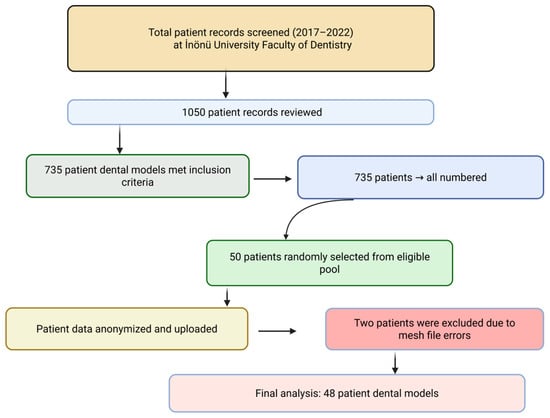
Figure 1.
Diagram showing the selection of patient dental models used in the study.
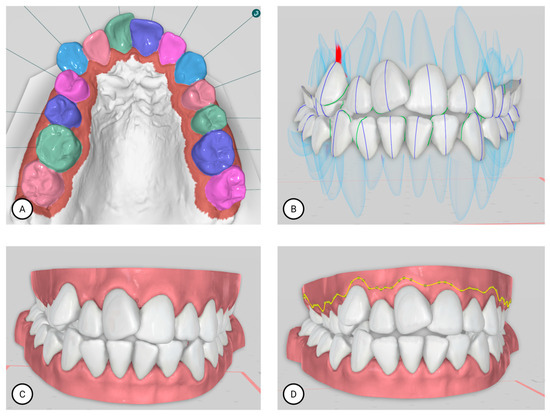
Figure 2.
Workflow in the Titan Dental Design program. (A): AI-assisted teeth segmentation. (B): Adjustment of facial axis and roots generated by the software. (C): Upper and lower arches ready for tooth movement planning after segmentation. (D): Automatically generated cutting line (for clear aligner margins).
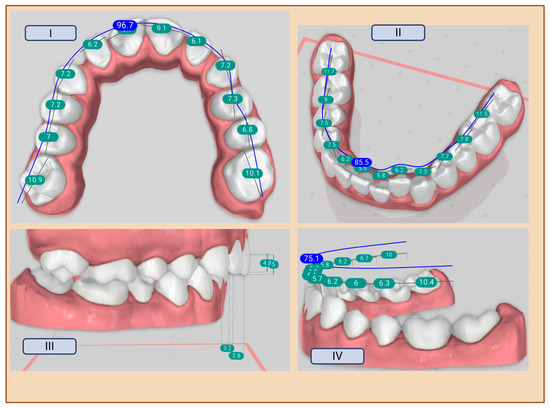
Figure 3.
Model analysis in the Titan Dental Design program. (I): Space analysis in the maxilla—mesiodistal widths of the teeth and the available arch length. (II): Space analysis in the mandible—note how the arch form is influenced by the tooth alignment in the software. (III): Overjet and overbite measurements. (IV): Available arch length measured from the distal of the first molars (tooth #6); space analysis was limited to the region up to the distal line of the first molars.
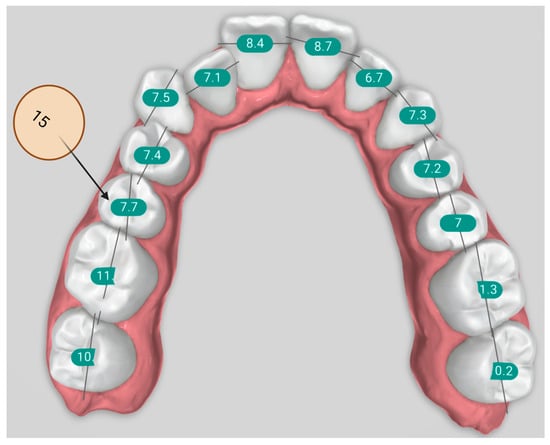
Figure 4.
Mesiodistal width measurements of the teeth in the Titan Dental Design software.
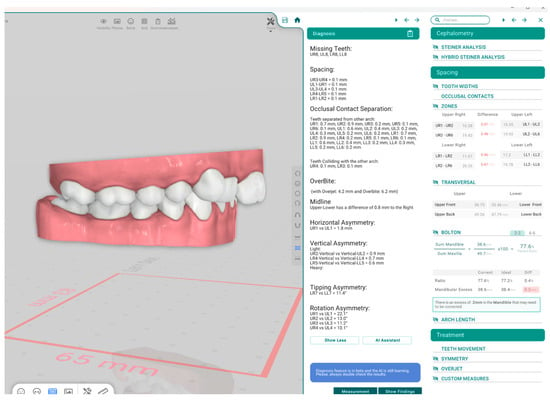
Figure 5.
An AI-assisted case evaluation in the Titan Dental Design program interface.
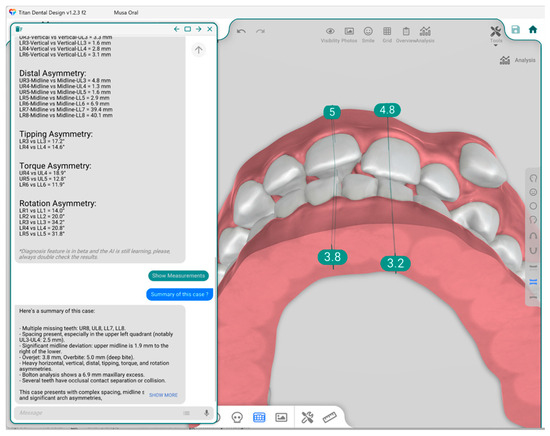
Figure 6.
Web-based AI panel displaying measurements after segmentation in the Titan Dental Design program.
- Bolton analysis (overall and anterior)
- Overjet and overbite measurements
- Space analysis
- Angle classification (right and left)
In SoftSmile (Figure 7 and Figure 8), only the Bolton analysis was evaluated, as the platform’s space calculations did not encompass the full dental arch. The 3Shape OrthoAnalyzer (Figure 9 and Figure 10) was used as the primary tool for manual measurements, with all analyses performed directly by three orthodontists. Two of the orthodontists had over ten years of clinical experience, while the third had one year of post-specialization experience. All examiners were trained in digital model analysis and had at least three years of experience using the 3Shape OrthoAnalyzer software. The 3Shape OrthoAnalyzer was selected as the reference standard for this study due to its well-established accuracy and reliability in orthodontic measurements, as supported by numerous studies in the literature [30,32,33]. For numerical data, the average values obtained from the three orthodontists were used. For categorical data, the value agreed upon by at least two of the three orthodontists was accepted as the final decision. This process was carried out by a resident.
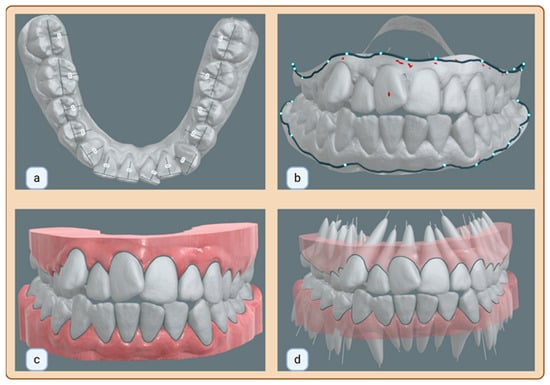
Figure 7.
Workflow in the SoftSmile Program. (a): AI-assisted identification of mesiodistal tooth widths. (b): Automatic detection of undesired measurement areas. (c): Tooth segmentation. (d): Generation of virtual roots by software.
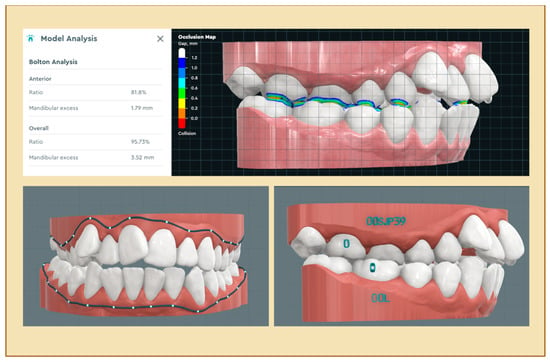
Figure 8.
Model analysis and various stages in the SoftSmile program.
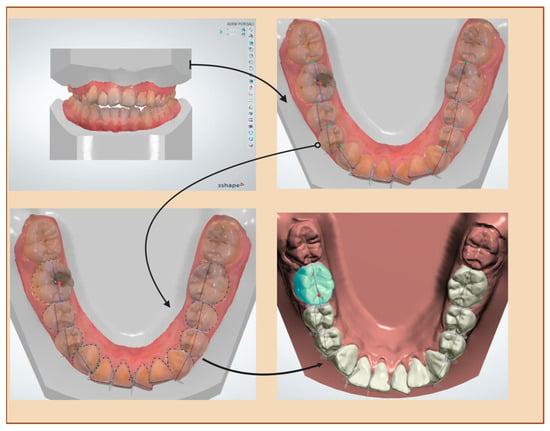
Figure 9.
Workflow in the 3Shape OrthoAnalyzer program: From intraoral digital scans to tooth segmentation.
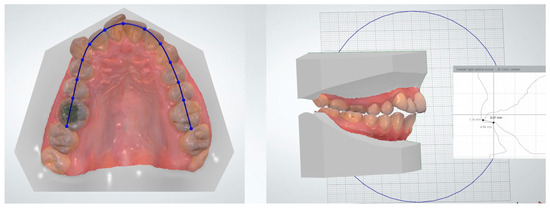
Figure 10.
Model analysis in the 3Shape OrthoAnalyzer program.
Orthodontists did not have access to the data generated by AI systems. Their involvement in the AI-assisted workflows was limited to assessing the quality of the automated segmentation. All AI-generated measurements were collected independently by a resident to maintain a clear separation between the manual evaluation and AI data processing steps.
In Bolton analyses, the focus was placed on identifying whether the tooth size discrepancy originated from the maxilla or mandible, rather than relying solely on ratio values, to better support clinical decision-making in interproximal reduction.
To assess method error, 20 patient scans were reuploaded into both artificial intelligence platforms using different case names after a two-week interval and analyzed using the same protocol. The same scans were also imported into the OrthoAnalyzer program and reanalyzed following identical procedures. Final data from all groups (Orthodontist, Titan, and SoftSmile) were recorded in Microsoft Excel (Microsoft Corporation, Redmond, WA, USA) and securely stored. Table 1 summarizes the evaluated parameters.

Table 1.
Tooth size, space, and model analysis parameters.
2.5. Ethical Approval
This study was approved by the İnönü University Ethics Committee (Approval No: 2024/6342) and was conducted in accordance with the principles of the Declaration of Helsinki. Patient data were anonymized to ensure confidentiality.
2.6. Statistical Analysis
All statistical analyses were performed using R version 4.2.2 (integrated in BioRender) and RStudio (v2025.05.0 + 496). Descriptive visualizations, including box plots, bar graphs with standard deviation (SD), and dot plots, were generated using BioRender. The normality of data distributions was assessed using the Shapiro–Wilk test. For paired comparisons of continuous variables, the paired t-test was used for normally distributed data, and the Wilcoxon signed-rank test was applied for non-normally distributed data. For comparisons among three related groups, repeated measures ANOVA was conducted for normally distributed variables, and the Friedman test was used for non-normal distributions. For categorical variables, including categorical comparisons between platforms and inter-rater agreement assessments, Cohen’s kappa statistic was used to evaluate the level of agreement [34]. A p-value of less than 0.05 was considered statistically significant.
3. Results
Cohen’s kappa analyses were conducted to evaluate the level of categorical agreement between the orthodontist and two AI-based diagnostic platforms (Titan and SoftSmile). In the Anterior Bolton analysis, no meaningful agreement was observed between the orthodontist and Titan (κ = −0.051), while SoftSmile demonstrated only minimal agreement (κ = 0.113). A moderate level of agreement was found between Titan and SoftSmile for the same parameter (κ = 0.496, p < 0.001). In the Overall Bolton analysis, neither AI system showed significant agreement with the orthodontist (Titan: κ = −0.077; SoftSmile: κ = −0.124), though a moderate agreement was again noted between the two platforms (κ = 0.406, p = 0.001). For molar classification, both right and left sides showed almost perfect agreement between the AI systems and the orthodontist (right: κ = 0.955; left: κ = 0.900; p < 0.001). Inter-examiner consistency between the two orthodontists revealed substantial agreement in the Anterior Bolton analysis (κ = 0.710) and moderate agreement in the Overall Bolton analysis (κ = 0.467) (Table 2).

Table 2.
Agreement on categorical orthodontic parameters between the orthodontist group and AI-based orthodontic software.
In Bolton analyses, the performance of all three groups was evaluated in cases where the tooth size excess was identified in the same jaw (either maxilla or mandible). Appropriate statistical tests were selected based on the distribution characteristics of the data. Specifically, the Friedman test was used for the anterior Bolton analysis due to non-normal distribution (Friedman statistic = 2.97, p = 0.226), while repeated measures ANOVA was applied to the overall Bolton analysis, which exhibited a normal distribution (F(2, 36) = 0.230, p = 0.795). Neither test revealed statistically significant differences among the groups. These findings suggest that in cases where the tooth size discrepancy was located in the same arch (maxilla or mandible), the evaluations were consistent across all groups in identifying the origin of the discrepancy (Figure 11).
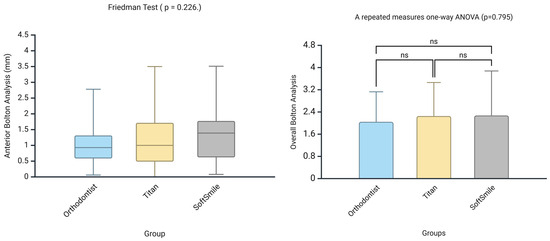
Figure 11.
Comparison of Anterior and Overall Bolton Analysis Values Among the Three Groups (Orthodontist, Titan, and SoftSmile). Friedman test for anterior analysis; repeated measures ANOVA for overall analysis. p < 0.05 indicates statistical significance.
Regarding overjet and overbite measurements, the data were not normally distributed, and the Wilcoxon signed-rank test was applied. A significant difference was observed between the Orthodontist group and the Titan group (p < 0.001) (Figure 12).
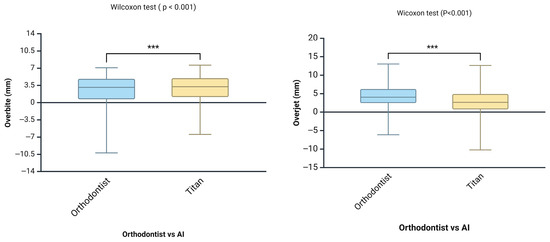
Figure 12.
Comparison of Overjet and Overbite Measurements Between Orthodontists and Titan AI. Wilcoxon signed-rank test, *** p < 0.001.
In the space analysis, the Wilcoxon signed-rank test was used for the maxillary arch, showing a significant difference between the Orthodontist group and the Titan group (p < 0.001; Figure 13). For the mandibular arch, the data were normally distributed; therefore, a paired t-test was conducted, which also revealed a significant difference between the Orthodontist and Titan groups (p < 0.001) (Figure 13).
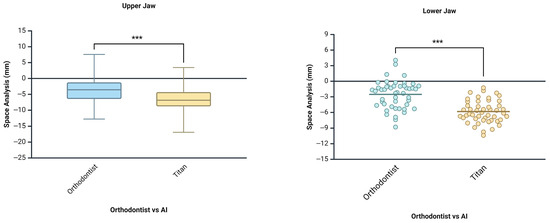
Figure 13.
Comparison of Space Analysis Values in the Upper and Lower Jaws Between Orthodontists and the Titan AI. Upper jaw: Wilcoxon signed-rank test (*** p < 0.001). Lower jaw: Paired t-test (*** p < 0.001).
Both inter-rater and intra-rater reliability within the Orthodontist group were assessed using Intraclass Correlation Coefficient (ICC) analysis. Intra-rater reliability was also evaluated for the AI-based platforms. For the SoftSmile system, only the Bolton analysis was re-assessed, whereas all variables were re-measured in the Titan Dental Designer to determine intra-rater consistency. Within the orthodontist group, the lowest ICC value for intra-rater reliability was 0.84, and for inter-rater reliability, it was 0.77, indicating good to excellent reliability. For Angle classification, Cohen’s kappa coefficient was 1.00 for both the orthodontist group and the AI platforms, indicating perfect agreement. Additionally, both AI-assisted platforms demonstrated excellent consistency in repeated measurements, with intra-rater ICC values exceeding 0.95.
4. Discussion
The present study aimed to assess the diagnostic accuracy of two AI-based software platforms, Titan Dental Design and SoftSmile, by comparing their automated measurements with those obtained manually by experienced orthodontists across six key parameters: molar relationship, overbite, overjet, lower arch space analysis, upper arch space analysis, and Bolton analysis. Statistically significant differences were observed in several parameters, including overjet, overbite, and space analysis in both arches, indicating that the AI tools used in this study have not yet reached the desired level of diagnostic accuracy for complex quantitative assessments.
However, no statistically significant differences were observed in anterior and overall Bolton analyses when the location of the tooth size discrepancy (maxillary or mandibular) was consistent across all groups. In fact, the traditional Bolton ratio itself was not the primary focus of our evaluation. Instead, the study prioritized determining the location of the discrepancy and then quantifying the amount of excess. This decision was based on clinical relevance, as interproximal reduction (IPR) is generally applied based on the specific site and magnitude of the discrepancy rather than the overall Bolton ratio.
Notably, the agreement between the orthodontists and the Titan AI system in molar relationship classification was almost perfect, as indicated by high Cohen’s kappa values. This suggests that AI systems may be reliably used in categorical occlusal evaluations.
In contrast, inconsistencies observed in overjet, overbite, and space analyses are likely attributable to difficulties in accurately identifying the mesial and distal contact points of teeth. Although both AI platforms performed adequately in segmenting individual teeth, visual inspection revealed that measurement discrepancies likely stemmed from subtle variations in how the algorithms defined proximal tooth boundaries, rather than from major segmentation errors. These findings highlight the need for further refinement of AI systems, particularly for measurements that require precise anatomical landmark identification.
Comprehensive diagnosis and treatment planning are essential components of successful orthodontic practice. Model analysis plays a critical role in this process [16]. It typically includes evaluations such as space analysis, Bolton analysis, dental relationships, and measurements of overjet and overbite. The generation and use of three-dimensional digital models have largely replaced traditional plaster models for these analyses [36].
Digital models can be obtained using various methods, including direct intraoral scanning, scanning of alginate or silicone impressions, digitization of plaster models with laboratory scanners, or imaging techniques such as cone beam computed tomography (CBCT) [37,38,39]. This digital transformation has enabled the visualization of both hard and soft tissues in electronic format and has helped establish digital models as a standard in orthodontic record keeping [37,38].
However, despite the widespread adoption of digital models, manual measurements performed on these models can still increase clinical workload and introduce variability among examiners [26]. To address these challenges, automation solutions powered by AI technologies have emerged, significantly reducing the burden of manual analysis and minimizing diagnostic inconsistencies [14,30]. These developments have expanded the role of AI beyond model analysis to a broader range of clinical applications in orthodontics [14,15,28,30].
AI is now widely used in diagnosis, treatment planning, and patient monitoring. In radiographic imaging, including lateral cephalograms [40], panoramic radiographs [41], and CBCT [42], AI has supported the automation of landmark identification, segmentation, classification, and analysis tasks, enhancing both speed and diagnostic accuracy [43,44]. Additionally, tasks such as model segmentation, landmark placement, three-dimensional surface analysis, and virtual tooth movement tracking have also been facilitated through AI technologies [43,45]. These advancements reduce the need for manual input, alleviate clinical workload, and improve the efficiency and precision of diagnosis and treatment planning [29].
However, to ensure clinical reliability, AI systems must undergo continuous training, testing, and validation. Therefore, assessing the agreement between AI-generated analyses and manual measurements on digital models is crucial. In this context, the findings of our study provide valuable insight into the diagnostic reliability of AI in orthodontics.
There was an almost perfect agreement between the orthodontist and the Titan AI system in the classification of malocclusion on both the right and left sides, with Cohen’s kappa values of 0.955 (right) and 0.900 (left), respectively (p < 0.001). Similarly, no statistically significant differences were observed among the three groups in the evaluation of anterior and overall Bolton analyses when the location of the tooth size discrepancy (maxillary or mandibular excess) was consistent (anterior: p = 0.226; overall: p = 0.795). This inconsistency may be attributed to errors in measuring mesiodistal dimensions, as illustrated in Figure 4, particularly in tooth 15.
On the other hand, statistically significant differences were observed between the Orthodontist group and the Titan group (AI) in the measurements of overjet, overbite, and space analysis (p < 0.001). Previous studies have primarily focused on comparing manual measurements performed on traditional dental casts with those obtained from digital intraoral scans. Santoro et al. [46] reported statistically significant differences between digital and manual measurements in parameters such as mesiodistal tooth width and overbite (p < 0.001), with values ranging from 0.16 to 0.49 mm. However, these differences were considered clinically negligible. In contrast, Quimby et al. [25] found no statistically significant differences between digital and plaster models across all evaluated parameters, including tooth width, arch length, and overjet (p > 0.05). Similarly, Stevens et al. [47] concluded that any differences observed between digital and traditional model measurements remained below clinically relevant thresholds and could be considered negligible in clinical practice. Notably, greater deviations have been reported in larger and more complex measurements, such as arch length and arch perimeter [27]. Furthermore, some studies have considered differences up to 0.2 mm to be clinically acceptable in repeated measurements, while others have reported that discrepancies up to 0.3 mm in digital models remain within tolerable limits [27,48].
The observed discrepancies in space analysis are believed to arise not only from potential inaccuracies in mesiodistal tooth width measurements but also from the method used to calculate the required arch length based on the defined arch form. In particular, in cases of crowding, the software may interpret the dental arch as a sequence of angular segments rather than as a smooth, continuous curve, which can lead to an overestimation of the space required (Figure 3).
As for the differences observed in overjet and overbite measurements, these are likely due to variations in reference points used during measurement. While orthodontists typically measure from the midpoint of the incisal edge of the upper incisors to the buccal surface of the lower incisors, Titan Dental Design appears to follow this pattern in simple cases. However, in more complex cases, it tends to take measurements from the central portion of the teeth instead.
However, the presence of statistically significant differences does not always indicate clinical relevance. In such cases, it becomes crucial to interpret the differences in relation to accepted clinical thresholds.
Some recent investigations have instead used two-dimensional intraoral photographs for AI-based diagnostic evaluation limits [13,49]. In one of these studies, Vaughan et al. [13] assessed the diagnostic accuracy of an AI-based tool (SmileMate) using standardized clinical photographs and reported only slight to moderate agreement with clinician assessments [13]. For comprehensive diagnostic evaluation and precise orthodontic treatment planning, the integration of artificial intelligence with 3D intraoral scan data holds considerable potential. Accordingly, the performance of currently tested AI models may provide valuable reference points for assessing the applicability of AI in clinical orthodontic diagnostics. Previous studies have investigated the validity and efficiency of digital model analyses in orthodontics, ranging from semi-automated software to fully AI-based platforms. Lang et al. [27] compared a semi-automated digital model analysis tool (OnyxCeph3) with conventional manual measurements and reported minimal measurement differences, most of which were clinically insignificant. However, their approach still required operator input and did not involve artificial intelligence. In contrast, a recent study by Yu et al. [30] evaluated the diagnostic performance of fully AI-driven software (LaonSetup) using 3D intraoral scans. While they reported strong agreement with orthodontists in numerical parameters such as overjet and overbite, their analysis did not include categorical diagnostic variables, such as molar classification or the localization of tooth size discrepancies.
In contrast, the present study distinguishes itself by employing fully AI-based diagnostic software platforms and by incorporating categorical evaluations, including Angle classification and the location of tooth size discrepancies. Moreover, statistically significant differences were observed between the Orthodontist group and the AI platforms for several parameters assessed in our study. This discrepancy may be attributed to insufficient training of the AI models or inherent algorithmic limitations within the platforms used. It is anticipated that the integration of larger and more diverse datasets could enhance the diagnostic performance of these systems.
Recent studies have explored the integration of AI into digital orthodontic workflows, particularly in tooth segmentation, reporting high accuracy and efficiency across various algorithms and complex anatomical regions [45,50]. In contrast, the present study offers a complementary perspective by shifting the emphasis from segmentation accuracy to the diagnostic reliability of AI-derived measurements in clinical orthodontic practice. To date, only a limited number of studies [30] have addressed this aspect, which underscores the novelty of our investigation.
The present study revealed that, despite the high internal consistency observed within both AI systems, no agreement was found between the Orthodontist group and either platform in identifying the arch (maxillary or mandibular) where the anterior or overall Bolton discrepancies were located. The Cohen’s kappa values for these comparisons were close to zero or even negative, indicating a lack of categorical concordance. Moreover, inter-examiner agreement among orthodontists was only substantial for the anterior region (κ = 0.71) and moderate for the overall assessment (κ = 0.467), underscoring both the subjectivity of manual Bolton analyses and the difficulty of achieving consistent evaluations even among experienced clinicians (Table 2).
Furthermore, notable inconsistencies were observed in parameters that require more complex anatomical landmark detection, such as overjet, overbite, and space analyses. These results emphasize both the current potential and the limitations of AI in orthodontic diagnostics, reinforcing the importance of continued algorithm refinement and clinician oversight in clinical use.
Titan Dental Designer includes a web-based AI panel (Figure 6) similar to ChatGPT, which allows users to interact with the software through case-specific questions and receive real-time responses. Although currently in beta, this feature reflects the platform’s direction toward integrated AI-driven clinical support. In contrast, the SoftSmile platform includes a similar tool known as Vision AI. However, access to this feature was not available to all users, and despite our request, access was not granted during the course of this study (https://www.youtube.com/watch?v=ZS9sye0v4aU, accessed on 8 July 2025).
Accurate tooth segmentation is a fundamental prerequisite for reliable AI-assisted orthodontic diagnostics and effective treatment planning. The precise identification of tooth boundaries, particularly the mesial and distal contacts, directly impacts the accuracy of model-based measurements. In this study, AI-based analyses showed high precision and consistency, as indicated by elevated ICC values. Although segmentation quality was not evaluated using metrological grade methods, each case was visually reviewed with attention to mesiodistal alignment during space analysis.
Both AI platforms allowed for easy correction of segmentation errors. In Titan Dental Design, users can quickly adjust boundaries using a brush-based interface. In SoftSmile, segmentation can be modified by adjusting key points along the boundary loop. Both approaches enable rapid refinement of results.
In terms of imaging capabilities, both platforms now support the import of CBCT data. However, only SoftSmile currently provides AI-assisted tooth segmentation directly from CBCT scans. Titan Dental Designer, on the other hand, offers complementary features such as face scanning, facial analysis, and cephalometric integration. These tools collectively underscore the versatility and expanding clinical potential of AI-based orthodontic software.
Although the parameters evaluated in this study were calculated by AI-driven platforms and are clinically significant for orthodontic diagnosis, minor manual adjustments were still needed during segmentation—particularly for refining gingival contours. This partial dependence on user input may be considered a limitation of the study.
The current investigation was conducted by a team of three orthodontists, including two experienced clinicians and one younger practitioner with expertise in digital technologies. For future research, we recommend adopting multicenter study designs and involving larger, more diverse clinical samples. Expanding the number of participating clinicians and datasets would enhance the generalizability and robustness of the findings.
5. Conclusions
- AI-based Titan Dental Design showed almost perfect agreement with orthodontists in molar classification, indicating strong reliability for simple categorical assessments.
- Although both AI systems showed limited agreement with the orthodontist in identifying the location of Bolton discrepancies, when the location of tooth size excess (maxillary or mandibular) was consistent across all groups, the numerical measurements were comparable, with no statistically significant differences observed.
- AI platforms may have limitations in accurately detecting key measurement points, such as mesiodistal tooth widths, which can affect the precision of tooth size discrepancy analyses.
- Until further improvements are made, such AI-based analyses should be interpreted with caution and should not replace clinical judgment in orthodontic decision-making.
Author Contributions
S.B.: conceptualization, data curation, methodology, validation, investigation, writing—review and editing. F.O.: conceptualization, methodology, validation, investigation, writing—review and editing. A.K.: measurement analysis, data curation. All authors have read and agreed to the published version of the manuscript.
Funding
This research received no external funding.
Institutional Review Board Statement
The study was conducted in accordance with the Declaration of Helsinki and approved by the Ethics Committee of İnönü University (protocol code 2024/6342 and date of approval 11 September 2024).
Informed Consent Statement
Informed consent was obtained from all subjects involved in the study.
Data Availability Statement
The original contributions presented in the study are included in the article; further inquiries can be directed to the corresponding author.
Conflicts of Interest
The authors declare no conflicts of interest.
References
- Kaushik, K.; Bhatt, S.; Gupta, R.Y.; Patadiya, H.H.; Luthra, A.; Rao, K.A. Intraoral Scanner in Dentistry: A Comprehensive Review. J. Adv. Med. Dent. Sci. Res. 2025, 13, 57–61. [Google Scholar]
- Rheude, B.; Sadowsky, P.L.; Ferriera, A.; Jacobson, A. An evaluation of the use of digital study models in orthodontic diagnosis and treatment planning. Angle Orthod. 2005, 75, 300–304. [Google Scholar]
- Sehrawat, S.; Kumar, A.; Grover, S.; Dogra, N.; Nindra, J.; Rathee, S.; Dahiya, M.; Kumar, A. Study of 3D scanning technologies and scanners in orthodontics. Mater. Today Proc. 2022, 56, 186–193. [Google Scholar] [CrossRef]
- Fujiyama, K.; Honjo, T.; Suzuki, M.; Matsuoka, S.; Deguchi, T. Analysis of pain level in cases treated with Invisalign aligner: Comparison with fixed edgewise appliance therapy. Prog. Orthod. 2014, 15, 1–7. [Google Scholar] [CrossRef]
- Miller, K.B.; McGorray, S.P.; Womack, R.; Quintero, J.C.; Perelmuter, M.; Gibson, J.; Dolan, T.A.; Wheeler, T.T. A comparison of treatment impacts between Invisalign aligner and fixed appliance therapy during the first week of treatment. Am. J. Orthod. Dentofac. Orthop. 2007, 131, 302.e1–302.e9. [Google Scholar] [CrossRef]
- Ruiz, D.C.; Mureșanu, S.; Du, X.; Elgarba, B.M.; Fontenele, R.C.; Jacobs, R. Unveiling the role of artificial intelligence applied to clear aligner therapy: A scoping review. J. Dent. 2025, 154, 105564. [Google Scholar] [CrossRef]
- Anwar, S.M.; Majid, M.; Qayyum, A.; Awais, M.; Alnowami, M.; Khan, M.K. Medical image analysis using convolutional neural networks: A review. J. Med. Syst. 2018, 42, 1–13. [Google Scholar] [CrossRef]
- Yamashita, R.; Nishio, M.; Do, R.K.G.; Togashi, K. Convolutional neural networks: An overview and application in radiology. Insights Imaging 2018, 9, 611–629. [Google Scholar] [CrossRef]
- Park, Y.H.; Kim, S.H.; Choi, Y.Y. Prediction models of early childhood caries based on machine learning algorithms. Int. J. Environ. Res. Public Health 2021, 18, 8613. [Google Scholar] [CrossRef]
- Kim, S.; Lee, Y.H.; Noh, Y.K.; Park, F.C.; Auh, Q.S. Age-group determination of living individuals using first molar images based on artificial intelligence. Sci. Rep. 2021, 11, 1073. [Google Scholar] [CrossRef]
- Tarce, M.; Zhou, Y.; Antonelli, A.; Becker, K. The Application of Artificial Intelligence for Tooth Segmentation in CBCT Images: A Systematic Review. Appl. Sci. 2024, 14, 6298. [Google Scholar] [CrossRef]
- Wang, X.; Alqahtani, K.A.; Van den Bogaert, T.; Shujaat, S.; Jacobs, R.; Shaheen, E. Convolutional Neural Network for Automated Tooth Segmentation on Intraoral Scans. BMC Oral Health 2024, 24, 804. [Google Scholar] [CrossRef]
- Vaughan, M.; Mheissen, S.; Cobourne, M.; Ahmed, F. Diagnostic accuracy of artificial intelligence for dental and occlusal parameters using standardized clinical photographs. Am. J. Orthod. Dentofac. Orthop. 2025, 167, 733–740. [Google Scholar] [CrossRef]
- Gracea, R.S.; Winderickx, N.; Vanheers, M.; Hendrickx, J.; Preda, F.; Shujaat, S.; de Llano-Perula, M.C.; Jacobs, R. Artificial intelligence for orthodontic diagnosis and treatment planning: A scoping review. J. Dent. 2024, 152, 105442. [Google Scholar] [CrossRef]
- Retrouvey, J.M. The role of AI and machine learning in contemporary orthodontics. APOS Trends Orthod. 2021, 11, 74–80. [Google Scholar] [CrossRef]
- Leifert, M.F.; Leifert, M.M.; Efstratiadis, S.S.; Cangialosi, T.J. Comparison of Space Analysis Evaluations with Digital Models and Plaster Dental Casts. Am. J. Orthod. Dentofac. Orthop. 2009, 136, 16.e1–16.e4. [Google Scholar] [CrossRef]
- Park, S.H.; Byun, S.H.; Oh, S.H.; Lee, H.L.; Kim, J.W.; Yang, B.E.; Park, I.Y. Evaluation of the reliability, reproducibility and validity of digital orthodontic measurements based on various digital models among young patients. J. Clin. Med. 2020, 9, 2728. [Google Scholar] [CrossRef]
- Nance, H. The Limitation of Orthodontic Treatment. Am. J. Orthod. 1947, 33, 253–301. [Google Scholar] [CrossRef]
- Bolton, W.A. The Clinical Application of a Tooth-Size Analysis. Am. J. Orthod. 1962, 48, 504–529. [Google Scholar] [CrossRef]
- Ülgen, M. Ortodonti: Anomaliler, Sefalometri, Etioloji, Büyüme ve Gelişim, Tanı; Yeditepe Üniversitesi: İstanbul, Türkiye, 2000. [Google Scholar]
- Nalcaci, R.; Topcuoglu, T.; Ozturk, F. Comparison of Bolton Analysis and Tooth Size Measurements Obtained Using Conventional and Three-Dimensional Orthodontic Models. Eur. J. Dent. 2013, 7 (Suppl. 1), S066–S070. [Google Scholar] [CrossRef]
- Akyalcin, S.; Dyer, D.J.; English, J.D.; Sar, C. Comparison of 3-Dimensional Dental Models from Different Sources: Diagnostic Accuracy and Surface Registration Analysis. Am. J. Orthod. Dentofac. Orthop. 2013, 144, 831–837. [Google Scholar] [CrossRef]
- Angle, E.H. Classification of Malocclusion. Dent. Cosm. 1899, 41, 350–357. [Google Scholar]
- Dewey, M. Classification of Malocclusion. Int. J. Orthod. 1915, 1, 133–147. [Google Scholar] [CrossRef]
- Quimby, M.L.; Vig, K.W.; Rashid, R.G.; Firestone, A.R. The Accuracy and Reliability of Measurements Made on Computer-Based Digital Models. Angle Orthod. 2004, 74, 298–303. [Google Scholar]
- Mok, C.W.; Zhou, L.; Mcgrath, C.; Hägg, U.; Bendeus, M. Digital Images as an Alternative to Orthodontic Casts in Assessing Malocclusion and Orthodontic Treatment Need. Acta Odontol. Scand. 2007, 65, 362–368. [Google Scholar] [CrossRef]
- Lang, F.A.; Lang, N.A.; Vorloeper, J.; Niederau, C.; Craveiro, R.B.; Knaup, I.; Wolf, M. Validation of a digital, partly automated three-dimensional cast analysis for evaluation of orthodontic treatment assessment. Head Face Med. 2025, 21, 1–14. [Google Scholar] [CrossRef]
- Faber, J.; Faber, C.; Faber, P. Artificial Intelligence in Orthodontics. APOS Trends Orthod. 2019, 9, 201–205. [Google Scholar] [CrossRef]
- Liu, J.; Cheng, Y.; Li, S.; Zhao, Z.; Wu, Z. Machine Learning in Orthodontics: Challenges and Perspectives. Adv. Clin. Exp. Med. 2021, 30, 1065–1074. [Google Scholar] [CrossRef]
- Yu, J.H.; Kim, J.H.; Liu, J.; Mangal, U.; Ahn, H.K.; Cha, J.Y. Reliability and time-based efficiency of artificial intelligence-based automatic digital model analysis system. Eur. J. Orthod. 2023, 45, 712–721. [Google Scholar] [CrossRef]
- Bossuyt, P.M.; Reitsma, J.B.; Bruns, D.E.; Gatsonis, C.A.; Glasziou, P.P.; Irwig, L.; Lijmer, J.G.; Moher, D.; Rennie, D.; de Vet, H.C.; et al. STARD 2015: An updated list of essential items for reporting diagnostic accuracy studies. Radiology 2015, 277, 826–832. [Google Scholar] [CrossRef]
- Camardella, L.T.; Ongkosuwito, E.M.; Penning, E.W.; Kuijpers-Jagtman, A.M.; Vilella, O.V.; Breuning, K.H. Accuracy and reliability of measurements performed using two different software programs on digital models generated using laser and computed tomography plaster model scanners. Korean J. Orthod. 2020, 50, 13. [Google Scholar] [CrossRef]
- Camardella, L.; Breuning, H.; Vasconcellos Vilella, O. Accuracy and reproducibility of measurements on plaster models and digital models created using an intraoral scanner. J. Orofac. Orthop. 2017, 78, 211–220. [Google Scholar] [CrossRef]
- Cohen, J. A coefficient of agreement for nominal scales. Educ. Psychol. Meas. 1960, 20, 37–46. [Google Scholar] [CrossRef]
- Landis, J.R.; Koch, G.G. The measurement of observer agreement for categorical data. Biometrics 1977, 33, 159–174. [Google Scholar] [CrossRef]
- Bootvong, K.; Liu, Z.; McGrath, C.; Hägg, U.; Wong, R.W.; Bendeus, M.; Yeung, S. Virtual Model Analysis as an Alternative Approach to Plaster Model Analysis: Reliability and Validity. Eur. J. Orthod. 2010, 32, 589–595. [Google Scholar] [CrossRef]
- Rossini, G.; Parrini, S.; Castroflorio, T.; Deregibus, A.; Debernardi, C.L. Diagnostic Accuracy and Measurement Sensitivity of Digital Models for Orthodontic Purposes: A Systematic Review. Am. J. Orthod. Dentofac. Orthop. 2016, 149, 161–170. [Google Scholar] [CrossRef]
- Fleming, P.; Marinho, V.; Johal, A. Orthodontic Measurements on Digital Study Models Compared with Plaster Models: A Systematic Review. Orthod. Craniofac. Res. 2011, 14, 1–16. [Google Scholar] [CrossRef]
- Hirogaki, Y.; Sohmura, T.; Satoh, H.; Takahashi, J.; Takada, K. Complete 3-D Reconstruction of Dental Cast Shape Using Perceptual Grouping. IEEE Trans. Med. Imaging 2001, 20, 1093–1101. [Google Scholar] [CrossRef]
- Bor, S.; Ciğerim, S.Ç.; Kotan, S. Comparison of AI-Assisted Cephalometric Analysis and Orthodontist-Performed Digital Tracing Analysis. Prog. Orthod. 2024, 25, 41. [Google Scholar] [CrossRef]
- Chandrashekar, G.; AlQarni, S.; Bumann, E.E.; Lee, Y. Collaborative Deep Learning Model for Tooth Segmentation and Identification Using Panoramic Radiographs. Comput. Biol. Med. 2022, 148, 105829. [Google Scholar] [CrossRef]
- Wang, L.; Gao, Y.; Shi, F.; Li, G.; Chen, K.C.; Tang, Z.; Xia, J.J.; Shen, D. Automated Segmentation of Dental CBCT Image with Prior-Guided Sequential Random Forests. Med. Phys. 2016, 43, 336–346. [Google Scholar] [CrossRef]
- Miranda, F.; Barone, S.; Gillot, M.; Baquero, B.; Anchling, L.; Hutin, N.; Gurgel, M.; Al Turkestani, N.; Huang, Y.; Massaro, C.; et al. Artificial Intelligence Applications in Orthodontics. J. Calif. Dent. Assoc. 2023, 51, 2195585. [Google Scholar] [CrossRef]
- Oğuz, F.; Bor, S.; Khanmohammadi, A.; Kıranşal, M. Evaluation of Condylar and Airway Volume in Skeletal Class I Patients with Different Vertical Growth Patterns. Appl. Sci. 2025, 15, 2794. [Google Scholar] [CrossRef]
- Im, J.; Kim, J.Y.; Yu, H.S.; Lee, K.J.; Choi, S.H.; Kim, J.H.; Ahn, H.K.; Cha, J.Y. Accuracy and Efficiency of Automatic Tooth Segmentation in Digital Dental Models Using Deep Learning. Sci. Rep. 2022, 12, 9429. [Google Scholar] [CrossRef] [PubMed]
- Santoro, M.; Galkin, S.; Teredesai, M.; Nicolay, O.F.; Cangialosi, T.J. Comparison of Measurements Made on Digital and Plaster Models. Am. J. Orthod. Dentofac. Orthop. 2003, 124, 101–105. [Google Scholar] [CrossRef] [PubMed]
- Stevens, D.R.; Flores-Mir, C.; Nebbe, B.; Raboud, D.W.; Heo, G.; Major, P.W. Validity, Reliability, and Reproducibility of Plaster vs Digital Study Models: Comparison of Peer Assessment Rating and Bolton Analysis and Their Constituent Measurements. Am. J. Orthod. Dentofac. Orthop. 2006, 129, 794–803. [Google Scholar] [CrossRef]
- Casko, J.S.; Vaden, J.L.; Kokich, V.G.; Damone, J.; James, R.D.; Cangialosi, T.J.; Riolo, M.L.; Owens, S.E.; Bills, E.D. Objective Grading System for Dental Casts and Panoramic Radiographs. Am. J. Orthod. Dentofac. Orthop. 1998, 114, 589–599. [Google Scholar] [CrossRef]
- Ryu, J.; Kim, Y.H.; Kim, T.W.; Jung, S.K. Evaluation of artificial intelligence model for crowding categorization and extraction diagnosis using intraoral photographs. Sci. Rep. 2023, 13, 5177. [Google Scholar] [CrossRef]
- Wu, T.-H.; Lian, C.; Lee, S.; Pastewait, M.; Piers, C.; Liu, J.; Wang, F.; Chiu, C.Y.; Wang, W.; Jackson, C.; et al. Two-Stage Mesh Deep Learning for Automated Tooth Segmentation and Landmark Localization on 3D Intraoral Scans. IEEE Trans. Med. Imaging 2022, 41, 3158–3166. [Google Scholar] [CrossRef]
Disclaimer/Publisher’s Note: The statements, opinions and data contained in all publications are solely those of the individual author(s) and contributor(s) and not of MDPI and/or the editor(s). MDPI and/or the editor(s) disclaim responsibility for any injury to people or property resulting from any ideas, methods, instructions or products referred to in the content. |
© 2025 by the authors. Licensee MDPI, Basel, Switzerland. This article is an open access article distributed under the terms and conditions of the Creative Commons Attribution (CC BY) license (https://creativecommons.org/licenses/by/4.0/).